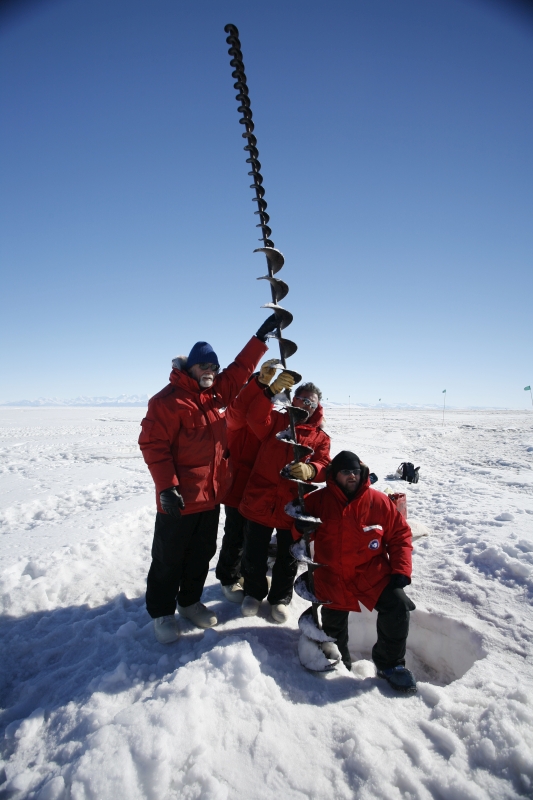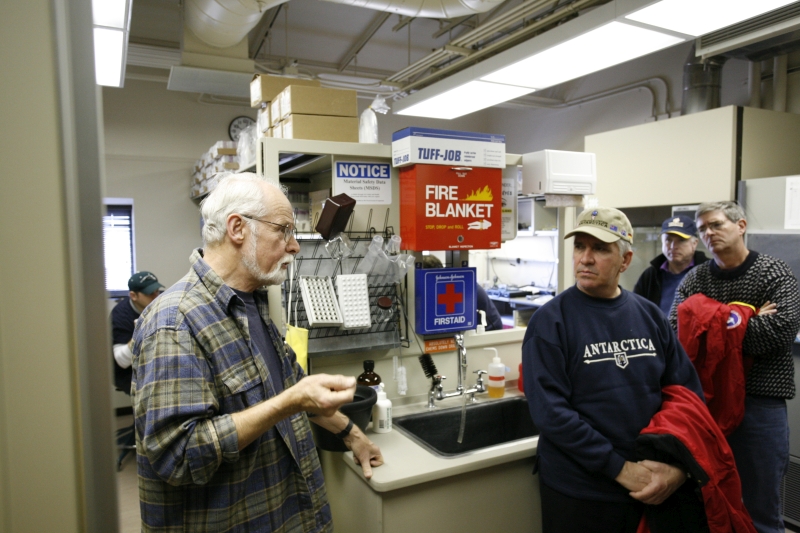1-8-06 Sunday
Today was the first class trip out on to the sea ice. We walked just a few
yards off the land at McMurdo out to the ice holes where I did the diving the
other day. The plan was to have this be an introduction to a few field
techniques for getting down to the water and taking various types of samples.
Although we had one hole already drilled for us, the students were tasked with
trying to drill their own holes, just to get the experience.
George Somero digging himself into a hole. George's many years of Antarctic experience allowed him to choose a spot where the snow on top of the ice was only about 1.5 feet deep, which was much easier to deal with than the spot that the students chose, where the snow was more like 3 feet deep.

The student hole started out small:

And it eventually got much larger with 15 people helping to dig;

We even finished it off with a nice stairway entrance so that people wouldn't break their necks trying to jump into the hole.

With the holes dug down to the ice we could start playing with the various ice drilling tools. Here Dave demonstrates how they did it in the old days with a hand-drill.

The more common way to drill holes, if you don't have a tractor to drill them for you, is to use one of these gas powered ice augers:

You just set it down on the ice in your hole, start it up, and lean on it. When you get down far enough, you can pull the drill out and add another section of drill shaft to extend your hole even deeper.

Here the students are pulling up the extended drill bit to clear the ice chips out of the hole.

This was as far as they got on the small drill bit size. The drill bit there is about nine feet tall, and they didn't hit sea water.

For George's hole they used a larger diameter (~8") auger to make a hole big enough to fish in. After 9 feet of big drill bits and another 6 feet of small bits added on, they still didn't make it through to the seawater. Tomorrow we need to get more drill sections.

Here is Mark Denny holding an ice coring tool. This drills in by hand and its hole center keeps a nice ice core for you to bring up and study.

The ice core that you get out looks exactly like you'd expect:

After all that unsuccessful drilling, people wandered back to our pre-drilled diving hole and took a bit of time to fish.

The fishies weren't biting today.
In other news, the Distinguished Visitors came for a tour of the lab this morning. George gave them a little introduction to what the course is about and what his own work is on. The guy in the back there is Mr. McCain from Arizona. The gentleman by the sink is the representative from the Fresno-Bakersfield area.

George Somero digging himself into a hole. George's many years of Antarctic experience allowed him to choose a spot where the snow on top of the ice was only about 1.5 feet deep, which was much easier to deal with than the spot that the students chose, where the snow was more like 3 feet deep.

The student hole started out small:

And it eventually got much larger with 15 people helping to dig;

We even finished it off with a nice stairway entrance so that people wouldn't break their necks trying to jump into the hole.

With the holes dug down to the ice we could start playing with the various ice drilling tools. Here Dave demonstrates how they did it in the old days with a hand-drill.

The more common way to drill holes, if you don't have a tractor to drill them for you, is to use one of these gas powered ice augers:

You just set it down on the ice in your hole, start it up, and lean on it. When you get down far enough, you can pull the drill out and add another section of drill shaft to extend your hole even deeper.

Here the students are pulling up the extended drill bit to clear the ice chips out of the hole.

This was as far as they got on the small drill bit size. The drill bit there is about nine feet tall, and they didn't hit sea water.

For George's hole they used a larger diameter (~8") auger to make a hole big enough to fish in. After 9 feet of big drill bits and another 6 feet of small bits added on, they still didn't make it through to the seawater. Tomorrow we need to get more drill sections.

Here is Mark Denny holding an ice coring tool. This drills in by hand and its hole center keeps a nice ice core for you to bring up and study.

The ice core that you get out looks exactly like you'd expect:

After all that unsuccessful drilling, people wandered back to our pre-drilled diving hole and took a bit of time to fish.

The fishies weren't biting today.
In other news, the Distinguished Visitors came for a tour of the lab this morning. George gave them a little introduction to what the course is about and what his own work is on. The guy in the back there is Mr. McCain from Arizona. The gentleman by the sink is the representative from the Fresno-Bakersfield area.


<< Home